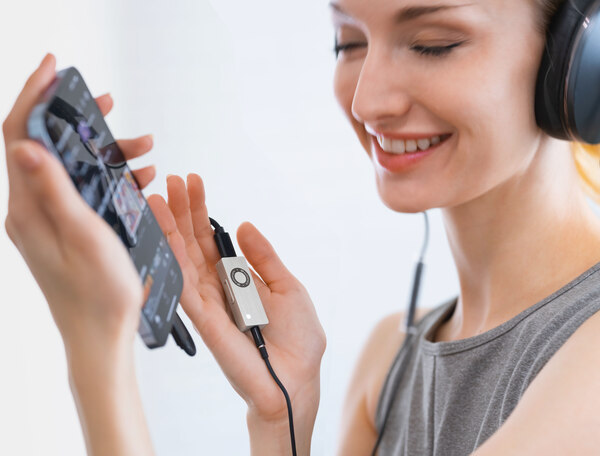About the Audioengine DAC3

A small DAC that delivers big sound
A small DAC that delivers big sound
Audioengine's DAC3 is probably the tiniest portable DAC I've ever had my hands on. For reference, it's smaller than a five-pack of chewing gum. But it has no trouble dishing out plenty of power and sweet sound despite its compact size. This DAC/headphone amp combo is a convenient way to get better sound from the music on your computer or smartphone, and it's sized just right for smaller desktop setups and listening on the go.

The small DAC3 fits comfortably in the palm of your hand. It won't get in your way if you need to tuck it in your pocket or bag, either.
Premium high-res processing and power
The DAC3 uses a premium ESS Sabre ES9281A PRO DAC chip. Audioengine chose this audiophile-grade chip because of its high signal-to-noise ratio and low total harmonic distortion (THD). It supports music files up to 32-bit/384kHz, plus MQA and DSD (up to DSD128).
The headphone amp is remarkable too. It provides quiet, consistent power for any pair of headphones rated at 12 ohms and up.
Convenient features
Audioengine managed to cram a lot of cool tech into the DAC3. There's a sample rate LED indicator on the front that verifies your source's quality. You can control your music's volume by using the "+" and "-" buttons on the side.
The DAC3 doesn't have a built-in battery, so you don't even need to charge it. The DAC is powered from whatever source device it's connected to (like your smartphone or computer) and requires very little power to run. The DAC3 stops drawing power when you disconnect your headphones to preserve the source device's battery life.
Easy to hook up
The connections on this DAC are straightforward. There's a USB-C port on top for connecting your source. Audioengine includes a USB-C-to-USB-C cable and a Lightning-to-USB-C cable in the box, making it compatible with most devices from the get-go. The bottom has a variable 3.5mm line-level output for connecting headphones, receivers, amps, and the like.
Hands-on (and ears-on) with the DAC3
I was a big fan of Audioengine's D3 DAC back in its heyday, so I was excited when I heard the company was releasing its spiritual successor. The DAC3 arrived in a small box with the DAC's basic specs listed on it. When I pulled it out of the box, I was baffled by its small size. I ran into the kitchen and grabbed a five-pack of chewing gum for comparison, and as I suspected, the DAC3 was a little smaller than the pack. Spoiler alert: it sounds way bigger than it looks. My demo left me smiling with nothing but praises. This little thing rocks!
A winning combination
To put this tiny DAC through its paces, I paired it with my trusty Grado open-back headphones. They're my go-to demo headphones because of how revealing they are. They also present an airy, almost lifelike soundstage when paired with a good DAC.
Getting warmed up
I like to demo new DACs by playing more relaxed songs first before moving into the realm of chaotic. The first track I played was the classic Blue Öyster Cult track "Cities on Flame with Rock and Roll." It's an old-school, '70s-era rock tune with a lot of funky drum stuff going on in the back. The DAC3 presented a surprisingly open soundstage with excellent separation across all the instruments. Albert Bouchard pulled double duty as both the singer and drummer on the track, and the DAC3 did a great job bringing his unique voice and cool drum patterns to life.
Exploring sonic depths
The DAC3 delivered stellar bass performance across several tracks. On Infected Mushroom's techno-infused cover of the '80s hit "Black Velvet," the dubstep bass part was impactful, energetic, and notably more articulate with the DAC than without it. The same was true on Tobe Nwigwe's "Try Jesus" and "Eat." The DAC3 rendered each song's deep sub-bass with controlled authority.
A tough test
Finishing out on a bang, I chose two songs that'd give even the most agile of DACs a run for their money: Tallah's "Overconfidence" and Lorna Shore's "To the Hellfire." Both of those songs present a good test: they each contain a complex, well-recorded mix with a lot of moving parts. I'm pleased to report that the DAC3 gave both songs depth and detail with plenty of separation between the different layers. The double bass and intricate guitar patterns in each song were easily intelligible amid the belts and shouts. I was floored by how well such a small DAC reproduced them.
Product highlights:
- portable USB digital-to-analog converter
- ESS Sabre ES9281A PRO 32-bit DAC chip with Hyperstream® II QUAD DAC™ architecture
- supported sample rates:
- PCM: up to 32-bit/384 kHz
- DSD: up to 5.6 MHz (DSD128)
- MQA
- works with most USB-C devices, including Android smartphones and Windows® and Mac® computers
- Lightning® adapter for iPhone® included
Other info:
- durable machined aluminum chassis
- 2-volt RMS output
- variable 3.5mm output for connecting DAC to headphones, amplifiers, receivers, and more
- no battery; uses source device for power
- powers off when 3.5mm connection is terminated and stops drawing power from source device
- onboard volume up/down buttons
- sampling rate indicator verifies source quality
- white: PCM 32 kHz-48 kHz
- green: PCM 88.2 kHz-192 kHz; DSD64
- blue: PCM 352.8 kHz-384 kHz; DSD128
- purple: MQA
- frequency response: 10-25,000 Hz ±0.5 dB
- signal-to-noise ratio: 116 dB
- total harmonic distortion: 0.002% @ 1 kHz
Dimensions and warranty:
- 1-7/8"W x 3/8"H x 9/16"D
- weight: 0.26 lbs.
- warranty: 3 years
- MFR # DAC3
What's in the box:
Audioengine DAC3 owner's manual
- USB digital-to-analog converter
- 5" USB-C to Apple Lightning cable
- 5" USB-C to USB-C cable
- Quick Start Guide
Featured video:
Customer reviews for Audioengine DAC3
Loading...
Loading reviews...
Average review:
4.5 out of 5 starsThanks for submitting your review
Customer photos
This review was collected as part of a promotion
Pros:
Cons:
More details on the Audioengine DAC3

Features & specs
| Design | ||
|---|---|---|
| Type | Portable | |
| Built-in Rechargable Battery | No | |
| Built-in Headphone Amplifier | ||
| Output Power | 2V | |
| Output Impedance (Unbalanced) | 2 ohms | |
| Output Impedance (Balanced) | N/A | |
| Audio Specs | ||
| Bit Depth (USB) | 32 | |
| Max Sampling Rate (USB) | 384 | |
| Bit Depth (S/PDIF) | 0 | |
| Max Sampling Rate S/PDIF | N/A | |
| S/N Ratio (Unbalanced, in dB) | 116 | |
| S/N Ratio (Balanced, in dB) | 0 | |
| THD (Unbalanced) | 0.002% | |
| THD (Balanced) | N/A | |
| Supported File Types | ||
| PCM | Up to 384kHz | |
| DSD | DSD 128 | |
| DXD | No | |
| MQA | Yes | |
| Inputs | ||
| Total Inputs | --- | |
| USB | USB-C | |
| Optical Digital | None | |
| Coaxial Digital | None | |
| 3.5mm Digital | None | |
| Stereo RCA Analog | None | |
| Stereo 3.5mm Analog | None | |
| Stereo XLR Analog | None | |
| Headphone Outputs | ||
| 3.5mm Unbalanced | 1 | |
| 1/4-inch Unbalanced | None | |
| 4.4mm Balanced | None | |
| XLR4 Balanced | None | |
| Other Headphone Outs | None | |
| Line Level & Digital Outs | ||
| RCA Line Out | None | |
| 3.5mm Line Out | None | |
| XLR Line Out | None | |
| Subwoofer Out | None | |
| Optical Digital Out | None | |
| Coaxial Digital Out | None | |
| Wireless Connectivity | ||
| Bluetooth | No | |
| Wi-Fi | No | |
| Apple-compatible | No | |
| Android-compatible | No | |
| General Info | ||
| Width (inches) | 0-3/4 | |
| Height (inches) | 0-3/8 | |
| Depth (inches) | 1-15/16 | |
| Weight | 0.4 lbs. | |
| Parts Warranty | 3 Years | |
| Labor Warranty | 3 Years | |
Product Research
Features
Overview: The Audioengine DAC3 is an ultra-compact digital-to-analog converter and portable headphone amplifier. The DAC3 features a metal-injection molded (MIM) case, with a volume control, a USB-C input, and a 3.5mm output. The high-performance 32-bit DAC supports standard Hi-Res audio formats, including PCM, DSD, and MQA. The headphone amp can drive headphones of 12 ohms or higher. The DAC3 comes with comes with USB-C and Lightning-to-USB-C cables for plugging into your phone, tablet, or computer. It can be used to bypass your computer's internal DAC or sound card for much higher fidelity and enhanced dynamic range.
D/A Converter: The DAC3 utilizes the ESS ES9281A PRO digital-to-analog converter, which is known for its low noise and high musical fidelity. It accepts digital audio files with bit depths up to 32 bits and sampling rates of up to 384kHz. The DAC3 features an asynchronous dual clock and 2-stage redundant USB power filtering for its accuracy and high signal-to-noise performance. The DAC3 can enhance your listening experience from your favorite streaming apps, such as Apple Music, Amazon Music, TIDAL, and Qobuz.
Audio Formats: The D/A converter will process PCM digital audio up to 384kHz, and supports DSD playback up to DSD128. It has MQA Renderer technology, allowing you to connect to an MQA Core signal an complete the final unfold of an MQA file. The LED indicator on the top of the DAC3 displays the audio format and bit rate in the following colors:
- White: PCM 32-48kHz
- Green: PCM 88.2-192kHz, DSD64
- Blue: PCM 352.8-384kHz, DSD128
- Purple: MQA Rendering
Headphone Amplifier: The DAC3's headphone amplifier contains the LME49726 op-amp, which can easily drive a wide range of headphones from 12Ω to 10kΩ. It can also provide a stable, 2-volt variable line output to an A/V receiver or powered speakers.
Power: The Audioengine DAC3 requires no external power or batteries. It is powered directly from the USB bus of your connected phone, tablet, or computer. The signal is filtered through two stages of regulation for better stability and fewer variations that may affect audio quality. The DAC3 requires a minimum USB input signal of 5V and 200mA.
Specifications:
- Frequency Response: 10Hz - 25kHz (+/- 0.5dB)
- Signal-to-Noise Ratio: >116dB
- THD+N: <0.002% (1 kHz FS 96kS/s)
- Crosstalk: -110dB
- Output Level: 2.0V RMS
- Output Impedance: 2Ω
- Recommended Headphone Impedance Range: 12Ω to 10kΩ
- Power Requirement: USB 5V, 200mA
- Temperature Range:
- Operating: 32° - 95° F
- Non-operating: -4° - 113° F
- Dimensions: Width 0.723", Height 0.353", Length 1.892"
- Weight: 0.4 ounces
Loading...
Loading accessories...
Customer Q&A
3 questions already asked
Loading...
Loading articles...












This DAC is perfect for my needs; It'small enough to attach to my iPhone 15 using my Sennheiser or Bose headphones to get an optimal sound quality for my music playlists. Plus it has a convenient volume control.
Jorge from Visalia, CA